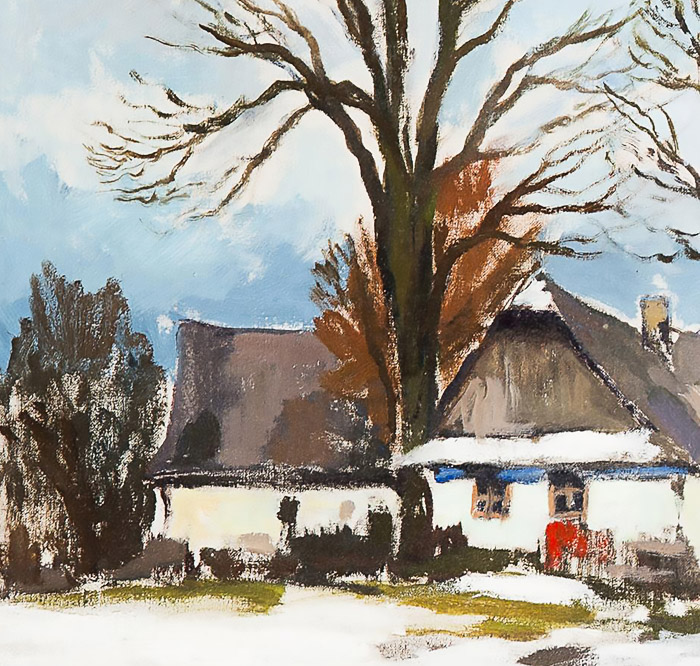

Long
Awaiting
Winter-to-Spring
& Other Painfully
Slow Transitions

Dr. Dixie Dillon Lane
When winter begins to blow away and the slush of March sets in, we turn our minds to the hope of spring. We long at this time for relief and celebration. Christmas is far behind us now, and late winter and early spring are the time to pore over seed catalogs, check the sales for warm-weather clothing (a couple of sizes up) for growing children, and generally look for a bit of hope in the muddy morass of long, unbroken weeks. The hot cocoa is all drunk up, and the winter coats are losing their waterproofing. We are ready for a party, for a warm day, for a change. We become radically impatient for a renewed sense of life.
But the end of winter does not result in the immediate arrival of spring. Instead, nature toys with our hopes at this time of year, plaguing us ruthlessly with meteorological indecision. Instead of turning one day into spring, late winter drags its feet unbearably while we stand there, waiting. Many regions experience a heartbreaking back-and-forth between sunshine and blizzards in these weeks and months, with the promise of crocuses routinely accompanied by an undignified reappearance of black ice. Even the Church, the ambassador of Good News, refuses to jump right to Easter at this time. Instead, in her wisdom, she, like the natural world, makes us wait.
Indeed, while at the beginning of winter we had Christmas to cheer our bones, at winter’s end we find no such solace. Easter does not usually come in March (and when it does, it is only at the very end). Instead, we are simply told to wait as we are handed yet another season of preparation and penance. Right at the moment when we are most tempted to give up the good fight, just when the schoolteachers and homeschoolers are universally burning out and whole families are knocked out with revolving colds and everything looks gray and hopeless, instead of a feast, we are hit with the forty-day fast — that is, the Lenten restriction and the holy call to extra-special generosity and self-sacrifice. And while we may make every effort to accept this ascetic season for the good of our souls, it is Easter we long for.
Nothing illustrates the difficulties of this late natural and liturgical season like having a Lenten birthday. My birthday and my husband’s both often land during Lent, mine toward the beginning and his toward the end. My husband’s birthday, in fact, quite frequently falls in Holy Week, on one or another of the great high holy days of preparation for the feast of the Resurrection. These are exciting days but also somber ones; Good Friday is one of only two fast days still required by our (Roman Catholic) church. The other is Ash Wednesday, the first day of Lent, which every once in a dreadful while falls exactly on my birthday. Or, comically, Ash Wednesday occasionally falls on Valentine’s Day, as it did in a couple of years ago. (The black humor that circulated among certain of my friends on that February 14 was something to remember; there’s nothing to put you in mind of romance like sackcloth and ashes.)
 My husband is much too mature to mind delaying his birthday when it falls on one of the especially penitential days of year, of course. When that happens, we usually just defer our celebration until Easter Monday, which is really quite a wonderful day for a family party. It would be much harder, I think, to defer a child’s special day; but in families that keep the Good Friday fast, for example, there really might sometimes be no way around it. Nor have I been able to be as sanguine about deferring my own birthday, I am ashamed to say. Indeed, I remember that the first time my birthday fell on Ash Wednesday, when I was a teenager, I was tied up in existential knots the whole day long. It felt wrong to fast on the anniversary of my birth, yet there I was, of course, fasting. But then, I was also happy, because it was my birthday. Is it wrong to feel happy while simultaneously wallowing in memento mori? Is it even possible?
My husband is much too mature to mind delaying his birthday when it falls on one of the especially penitential days of year, of course. When that happens, we usually just defer our celebration until Easter Monday, which is really quite a wonderful day for a family party. It would be much harder, I think, to defer a child’s special day; but in families that keep the Good Friday fast, for example, there really might sometimes be no way around it. Nor have I been able to be as sanguine about deferring my own birthday, I am ashamed to say. Indeed, I remember that the first time my birthday fell on Ash Wednesday, when I was a teenager, I was tied up in existential knots the whole day long. It felt wrong to fast on the anniversary of my birth, yet there I was, of course, fasting. But then, I was also happy, because it was my birthday. Is it wrong to feel happy while simultaneously wallowing in memento mori? Is it even possible?
Oddly enough, there is a way in which this paradox of feeling makes good sense. This short in-between in which we await birth and joy while contemplating death and sobriety mimics perfectly the natural world in this season. At this time of seemingly endless waiting for spring, there is something appropriate about the periodic harshness of the weather. The barrenness of the landscape is the necessary precursor of the fertility to come; as in human families, the creation of new life awaits God’s timing.

The barrenness of the landscape is the necessary precursor of the fertility to come; as in human families, the creation of new life awaits God’s timing.

Yet the two are inextricably linked: we remember death in the Crucifixion, but the Resurrection conquers it only three days later, in a flash of power so irreversible that the dread of death suddenly becomes absurd. On Easter Sunday, death is no longer the least bit frightening. Indeed, although the day in between — Holy Saturday — has often been observed penitentially, even with fasting and silence, there is always a sense of relief on that day, because we know that “it is finished.” Now that death has come, we know that life awaits us in the morning. We are no longer waiting for death; we are waiting between death and life.
When I became a mother for the first time I realized quite suddenly that birth is intimately intertwined with death. Not only is there within childbirth the fear of death for mother, child, or both, but even a smooth and healthy delivery is a sort of crucifixion. Ceding control of her body, the mother lays down her life in her labor; she dies to herself almost entirely and is rewarded, God willing, with the coming forth of a new, irreplaceable life from her sacrifice. Now when my birthday falls in Lent, I think to myself of my own mother, and how she did this for me. In her time of painful waiting, she was one with Christ, and there is only one outcome to Christ’s suffering: Easter follows. O happy fault, O necessary sin of Adam, which gained for us so great a Redeemer, we proclaim at Easter. There is a joy in the place of waiting; birth is there with us even in times of penance or of death.
Well may it be so in this season. This discomfort, this impatience, this late waiting and the penances and paradoxes may be trying or confusing, but really, it is right that this time of preparation and patience should contain both hardship and flashes of joy and light. It should not surprise us that this in-between time is not just one thing. For like the spring, the path to new life comes slowly and unpredictably; but we are not alone within it. It is built for our good, so that when spring comes — when the tomb is opened and the Light shines forth in all its glory — it can come to us so fully that it wipes away the winter altogether.
We can take some encouragement, then, as we wade through the slush looking for crocuses, in knowing that it is worthwhile to put aside our self-indulgence and embrace self-discipline for just a little longer at this time of year. After all, as much as I may have wished at times that Ash Wednesday could be suited to birthday cake, we know what much better thing comes at the end of our long awaiting. Without winter, there is no spring.


